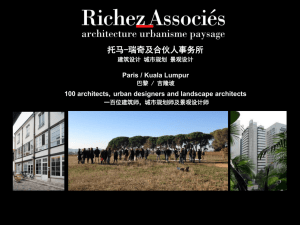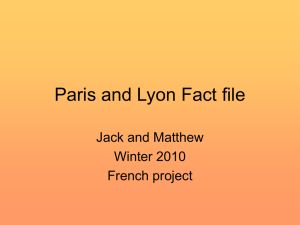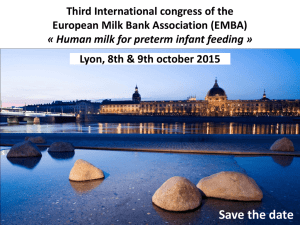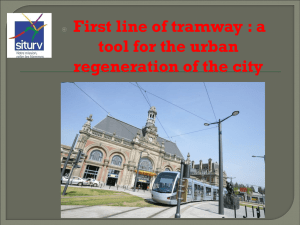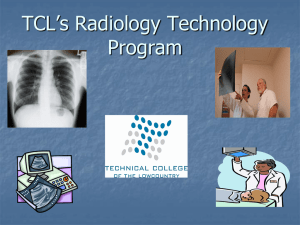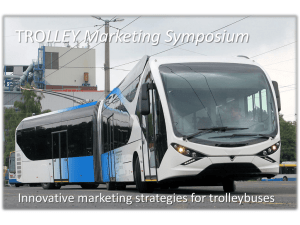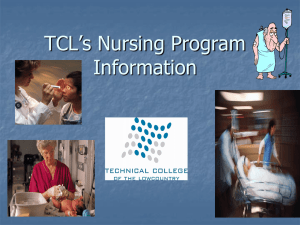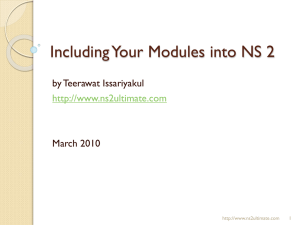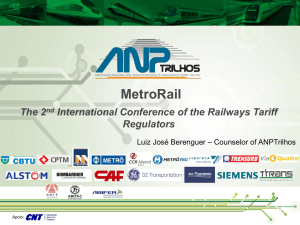1 Presentation of public transport in Lyon
advertisement
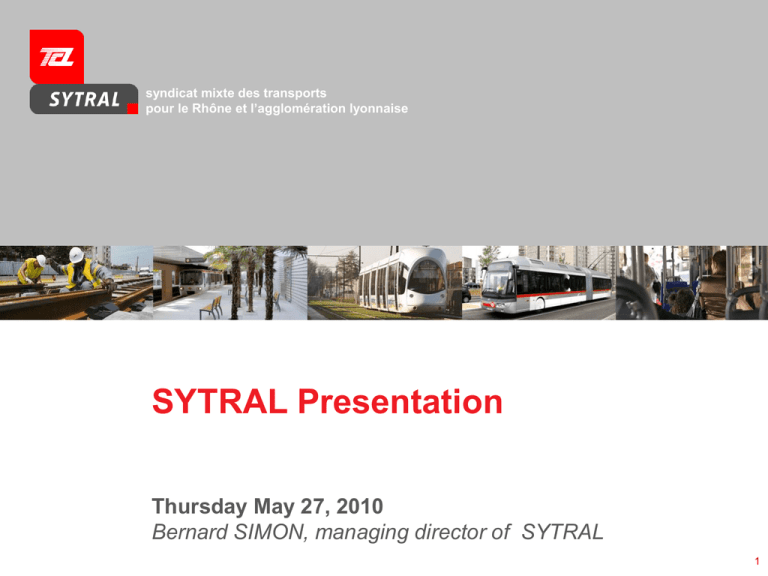
syndicat mixte des transports pour le Rhône et l’agglomération lyonnaise SYTRAL Presentation Thursday May 27, 2010 Bernard SIMON, managing director of SYTRAL 1 PART 1: A presentation of SYTRAL and the TCL system The Rhône-Alpes region and Rhône County The transport authority's capabilities: - The Rhône-Alpes region: Passenger rail service Rhône / Lyon Rhône-Alpes - Rhône County: region Interurban and school coach services. -SYTRAL: Urban transport in the Lyon metropolitan area. 3 SYTRAL's operating area and other urban centers Lyon metropolitan area: 1.3 million inhabitants 613 sq. km 57 surrounding towns and 7 outlying communities 120 km 30 km St-Etienne metropolitan area 500,000 inhabitants SYTRAL's structure 10 elected members of Rhône county 16 elected members of the Lyon Urban Community SYTRAL supervisory board 26 representatives Executive board 8 representatives President: Bernard Rivalta Vice-President: Georges Barriol SYTRAL Management 90 staff 5 The role of SYTRAL Defines and implements public transport policy, the service and fares. Finances the system and its development. Delegates the running of the system to external operator: Monitors the operator's performance and sanctions non-compliance. Supervises infrastructure and equipment projects. Performs traffic monitoring and client surveys. Owns the rolling stock, buildings and equipment 6 The public transportation system Largest system outside of Paris in terms of service and multimodal connections, with 5 different transport modes: Metro: 4 lines,178 cars, 30.3 km and 43 stations Funicular: 2 lines, 6 cars and 1.2 km Tramway: 4 lines, 73 trams, 48.8 km and 81 stations Trolleybus: 7 lines, 120 buses and 45 km Bus and minibus: 98 lines, 860 buses and 1142 km School bus: 141 lines, 112 buses and 1060 km 7 1.4 million journeys every day Metro: 655 588 passengers / day Tramway: 209 371 passengers / day Bus: 498 762 passengers / day - Trolleybus: 92 104 (lines C1, C3, 4, 6, 11, 13, 18) - Electric minibus: 2 322 (line 91) Funicular: 11 833 passengers / day 8 SYTRAL's budget 2010 Revenue: €684 M Spending: €684 M Spending: Revenue: Loans €103.3 M Miscellaneous revenues €29.9 M Transport tax €244.1 M 4 15 % % Administrative expenses and miscellaneous: €9 M Loans €141.3 M 1 21 % 36 % 49 % 21 % Local authority contribution % 24 % Investments €200.6 M 29 % €141 M Customers €165.7 M Operating expenses €333.1 M The TCL system today: Dense coverage and connections between the public transport system and roadways thanks to park & ride facilities on the outskirts of town 70% of all services is electrically powered Every metro station, tram and C1 trolleybus is accessible, with the exception of CroixPaquet station. 10 The 2008 > 2014 Development Plan DP investment: €342 M Recurring investment: €292.3 M Ouest Lyonnais express line 11 PART 2: What are the challenges ? The mains lines of the urban mobility policy since 1997 To provide a place for all types of transport in the municipality for both passengers and goods. To make the city accessible to everyone, including the mobility impaired and low income people Reduce the negative impact of traffic, to improve the quality of life in the city, to travel safely around the city. To inform, communicate and make the population aware, because replacing the car with clean, public transportation and can only work if the inhabitants accept it. 13 The main goals of the urban mobility policy since 1997 Extensive operating hours from 5 am to midnight with frequencies of 5 to 10 minutes. Reduced journey time thanks to the planning of priority routes for public transport. Comfort while you wait and throughout your journey: Guarantee that public transport is accessible to all. Improve real-time information updates for users Provide electric, modern, comfortable and airconditioned vehicles 14 Trends: Progress over the last 10 years The challenge: connect with the rail network... Build closer to stations to dissuade people from using their cars. Today 80% of the population lives within a 5 km radius of a station. Urban planning objective: 60% of new housing is either built in existing urban areas or near stations. Example: new Jean Macé station: The challenge: to establish an inter modal system REAL: a multimodal system Trains + interurban coaches + urban transport Since December 1, 2007: TER (regional trains) + TCL (Lyon public transport) Since January 1, 2008: Rhône coach + TCL End of 2009: STAS (Saint-Etienne urban transport) + TER + TCL End of 2009 : TAG (Grenoble urban transport) + TER + TCL For use on the Lyon public transport only (TCL system) For use on both the Lyon public transport and the regional trains system TER and/or TCL) 17 The challenge: develop park & ride services 20 TCL park & ride sites Over 6500 spaces + : a high fill rate in most of the park-andrides (from 90% to 100% of the spaces used). - : but some park & rides, at the end of tram lines, are under used. 18 The challenge: provide dense coverage A map of the main lines circa 2012: Share the roads and reduce car traffic Before the tramway: 50,000 vehicles/day Noise = 72 dB / day The T2 tramway - Avenue Berthelot With the tramway: 26,000 vehicles/day Noise = 68 dB / day Serving all the districts: a city policy Pendant les travaux : Serving all the districts: a city policy Example: The T4 tramway The opening of the T4 tramway from Minguettes to Vénissieux is part of the city's major development project with: The construction of 93 homes The renovation of public facilities (cinema, school of music, designated development area etc.). Renovation of a shopping center. Green spaces: The renovation project also aims to balance out urban functionality (tramway, cycle paths and roads) with green areas that are suited to the area. Reducing Energy Consumption Example: a protocol agreement with AREVA September 18, 2008: A protocol agreement was signed between SYTRAL and AREVA for the efficient energy supply and consumption of Lyon's public transport system. The main lines of this agreement: energy-efficient rolling stock, the recovery, storage and distribution of electric energy, the production and storage of hydrogen and its use in fuel cells… Making more room for electrical transport modes Examples: the metro, the tramway, the trolleybus… SYTRAL hopes to develop environmentally-friendly modes of transport by developing the tramway, the trolley bus and metro networks. The main Cristalis and trolleybus lines: - yesterday: C3 and C1 - today: C1 and C2 Electric minibus shuttles on the Presqu’île: Current experiments with these fuel-cell vehicles are proving to be pertinent and may lead to an increase in the vehicles' range from approximately 120 km to 300 km. Improving the quality of electrical modes Example: a new automatic piloting system of the metro Objective: to optimize the operation in order to keep energy consumption to a minimum. To swap the traction and breaking mode for a 'coasting' mode which means a slower but longer acceleration (thus the train breaks slowly). Implementation: The metro line D runs entirely on automatic pilot and uses this 'coasting' mode. This mode will be implemented on the A and B lines during the replacement of the automatic pilot systems. Reducing Energy Consumption A few examples: Measures implemented in the name of sustainable development: Installation of photovoltaic panels (on the Visulys information panels, park & rides…). Installation of catalytic converters and particle filters on our fleet of heat-engine buses Drivers trained to drive smoothly to consume less fuel. Development of electrical modes both in terms of quantity and quality. Adapting the service to meet the demand Example: renovating the cars on the metro line D A new interior design of the cars to increase passenger capacity: Increase passenger capacity from 12 to 15% - Currently: 270,000 passengers / day i.e. 9000 passengers/ direction/ hour - Forecast for 2010: 10,000 passengers/ direction / hour - Better distribution of the passengers within the train, - Improving ease of access and exit, - Reduced stop times at each station. - Prioritizing public transport Example: the trolley detection device at traffic lights This device the reduces the circuit times by 10 to 15 %. -Adapts the traffic light cycle to the vehicle. - Traffic light automatically turns green as the trolleybus approaches. Improving energy performance Example: local authorities produce and share electricity Trend: While electricity cannot be stored, the rush hour creates peaks in demand. This is costly. The project: To group together various public actors and produce electricity based on the principle that their individual peaks in consumption are not liable to occur simultaneously. This would enable these different actors to pool their resources and make financial savings. Examples: Public lighting at night in communities, rush hour traffic on Lyon's public transport system (TCL) etc.
